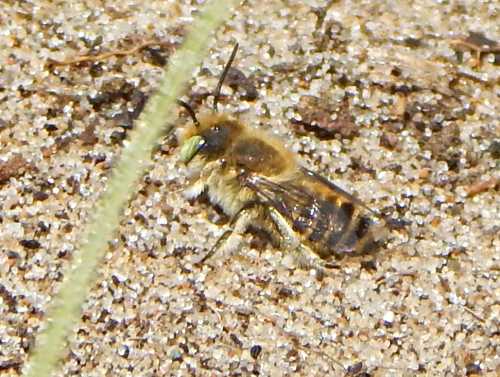Bird’s Foot Trefoil: Wildflower Beneficial For Bees
Bird’s foot
trefoil - a wildflower offering an abundance of nectar and pollen for bees.
Until a few years ago, I had a patch of bird’s foot trefoil - Lotus corniculatus – in a rockery area in my front garden. Bird’s foot trefoil is a wonderful wildflower for bees, and like many wildflowers, it looks very beautiful when sympathetically incorporated into the garden.
Unfortunately, I no longer have this plant – it didn’t survive competition from other plants in my rockery which were more vigorous, and established themselves very rapidly. However, where I live there are many patches of this wonderful, and very beautiful low growing wildflower, all appreciated by the local bee population.
Why is bird’s foot trefoil a wonderful wildflower for bees?

1. Nectar
The nectar production of bird’s foot trefoil was studied by scientists, Murrell
et al, and the results presented in a paper: FLORAL CHARACTERISTICS IN
BIRDSFOOT TREFOIL (Lotus corniculatus L.)(1)
Murrell and her team collected nectar from the flower umbels, using the centrifuge method.
Results Interestingly, they actually compared the nectar and sugar output of 8 different varieties of bird’s foot trefoil.
They found that 3 varieties: 'Carroll', 'Leo' and 'Empire' were high yielders in comparison with the others tested. Each produced upto 5.07; 3.99 and 3.52 micro-litres of nectar per umbel respectively.
However, this is not the whole story. For example, one variety, 'Wallace', had a stronger aroma and lower volume of nectar per umbel, however, the nectar was relatively concentrated and the variety produced an abundance of flowers, thus making it a potentially rich nectar reward for foraging bees.
Likewise, the variety 'Empire' produced upto 3.52 micro-litres of nectar per umbel, but the potential sugar per plant was 564mg. Nevertheless, the variety 'Carroll' preformed especially well, having the highest nectar yield of the varieties, and having a sugar production potential of 559mg per plant.
2. Pollen
Additionally, bird’s foot trefoil provides pollen. However, the flower petals are so arranged so that the visiting bee has to prise open the lateral petals of the flower in order to get access to the pollen inside the flower.
The pollen is vital for the bees as a food for larvae. Because the bee must work hard to get to the pollen, a few grains will inevitably stick to the furry coat of the bee and be transferred to the next flower visited, and hence pollination of the flower will occur. Read about how bees collect pollen.
Solitary bees and bumblebees are exceptional
pollinators of bird’s foot trefoil, as are honey bees.
Indeed, bees may pay multiple visits to bird’s foot trefoil for the purpose of gathering pollen as well as nectar, and due to its importance as a commercial forage crop, bees are well known to provide an important pollination service, helping to increase the production of seed. For example, in one study (2), honey bees would pay as many as 25 visits on flowers which remained open for 4 or 5 days, and that 12 - 25 visits per floret resulted in significantly higher seed production.
Growing conditions
Like many other wildflowers, bird’s foot trefoil is a wildflower which will survive well in poorly drained soils. It needs a sunny spot, and may take a little time to establish itself if grown from seed.

This swathe of bird’s foot trefoil and clover (above) provides wonderful foraging opportunities for bees living in this sandy coastal landscape, including bumblebees and solitary bees, such as the silvery leafcutter bee (which may use the petals for the construction of its nest cells - male Silvery Leafcutter pictured below).

This patch of bird’s foot trefoil (below) in the foreground thrives in a protected meadow setting.

The patch of bird’s foot trefoil here is located on a brownfield site (also a magnet for pollinators) where soil is shallow.
Other benefits of bird’s foot trefoil
Like the other legumes, alfalfa and clover, bird’s foot trefoil is not only helpful for bees, it is a useful forage plant for livestock, and indeed, is one of the wildflowers often recommended for use in a bee-friendly pasture system.
It also has some nitrogen fixing ability, and so can help improve soil quality, and mowings can be put into the compost heap and used as a green fertilizer.
Refs:
(1) FLORAL CHARACTERISTICS IN BIRDSFOOT TREFOIL (Lotus corniculatus L.) DOROTHY C. MURRELL, R. W. SHUEL, D. T. TOMES. Canadian Journal of Plant Science, 1982, 62(2): 361-371, 10.4141/cjps82-055.
(2) Effect of Pollen and Nectar Collecting Honeybees on the Seed Yield of Birdsfoot Treoil, Lotus Corniculatus L. K. L. Bader and S. R. Anderson, 1962.